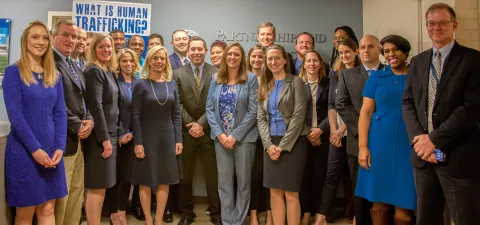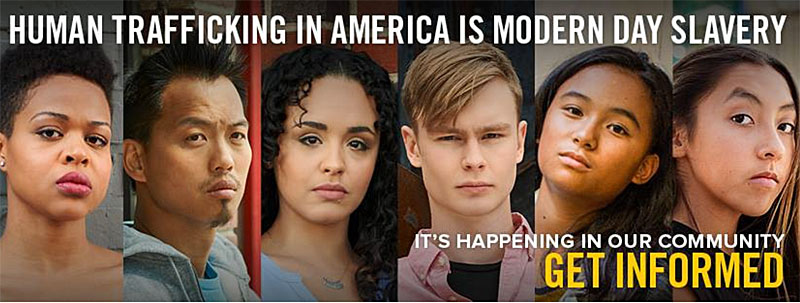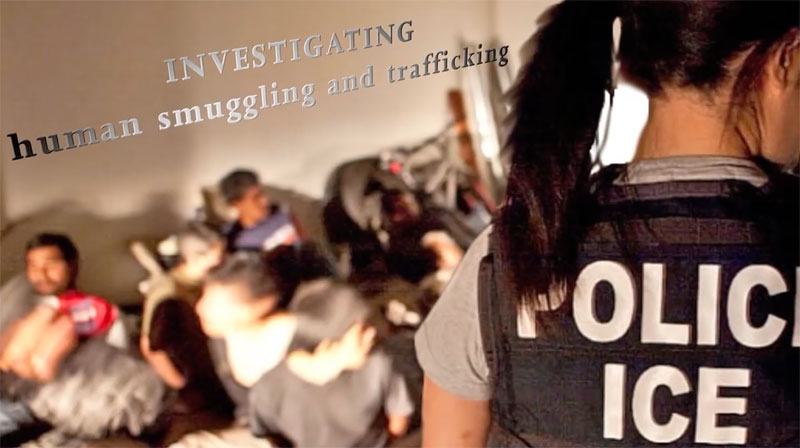Power of Partners
The Department of Homeland Security’s (DHS) Blue Campaign needs your help encouraging communities to learn how to recognize and report human trafficking – we rely on individuals and organizations to help spread the word.

Here are some ways to participate and examples of partners who were actively involved last year:
- Promote content on Facebook and Twitter using the hashtags #BlueCampaign and #EndTrafficking.
- The Connecticut Department of Children and Families launched a photo challenge in 2017 to support #WearBlueDay – flooding Twitter with photos of staff wearing blue clothing. You can do the same or create your own online challenge!
- Host an in-person or online event for your community and share free Blue Campaign resources.
- The DC Mayor’s Office teamed up with Blue Campaign on National Human Trafficking Awareness Day to host a panel discussion featuring local organizations, government representatives, and a human trafficking survivor.
- Highlight Blue Campaign resources on your website, in newsletters, or other publications.
- Amtrak encouraged station staff, Amtrak police, and riders to be more aware of human trafficking by featuring Blue Campaign in its newsletter and running the Blue Campaign public service announcement (PSA) in train stations nationwide.
- Join our efforts throughout the month, including #WearBlueDay, Thunderclap, and our Facebook Live panel discussion.
(The Blue Campaign is the unified voice for the U.S. Department of Homeland Security’s (DHS) efforts to combat human trafficking. Working in collaboration with law enforcement, government, non-governmental and private organizations, the Blue Campaign strives to protect the basic right of freedom and to bring those who exploit human lives to justice. Courtesy of DHS and YouTube.)
“Make no mistake, human trafficking is modern-day slavery,” explained Secretary of Homeland Security Kirstjen M. Nielsen today, Human Trafficking Awareness Day.
“Through use of force, fraud, or coercion, people around the world are robbed of their freedom and forced into labor or commercial sex acts.”

“Human traffickers do not discriminate based on nationality, age, gender, or socioeconomic status.”
“Across the world—in rural towns and urban areas alike—innocent men and women are targeted and exploited.”
“Human trafficking is the antithesis of everything the free world represents, and the Department of Homeland Security is not standing idly by.”
“In airports, along borders, and in communities across the country, our officers and agents are trained to identify those being victimized by criminals, including transnational criminal organizations.”
“Through President Trump’s immigration priorities, we will secure our borders, enforce laws within our country, and create an immigration system that protects the American people.”
“By empowering law enforcement officers to do their jobs and providing them with the resources they need, we can more effectively combat human trafficking.”
“Today, we reaffirm our commitment to eradicate modern slavery and human trafficking.”
“I encourage all Americans to learn how to recognize the signs of trafficking, and join the fight to end these heinous crimes.”
(The Blue Campaign infographic resources will help you to answer the question, “What is Human Trafficking?” Please help us bring this crime out of the shadows by sharing these materials on social media. Courtesy of DHS and YouTube.)
Indicators of Human Trafficking
Recognizing key indicators of human trafficking is the first step in identifying victims and can help save a life.
Here are some common indicators to help recognize human trafficking:

- Does the person appear disconnected from family, friends, community organizations, or houses of worship?
- Has a child stopped attending school?
- Has the person had a sudden or dramatic change in behavior?
- Is a juvenile engaged in commercial sex acts?
- Is the person disoriented or confused, or showing signs of mental or physical abuse?
- Does the person have bruises in various stages of healing?
- Is the person fearful, timid, or submissive?
- Does the person show signs of having been denied food, water, sleep, or medical care?
- Is the person often in the company of someone to whom he or she defers? Or someone who seems to be in control of the situation, e.g., where they go or who they talk to?
- Does the person appear to be coached on what to say?
- Is the person living in unsuitable conditions?
- Does the person lack personal possessions and appear not to have a stable living situation?
- Does the person have freedom of movement? Can the person freely leave where they live? Are there unreasonable security measures?
Not all indicators listed above are present in every human trafficking situation, and the presence or absence of any of the indicators is not necessarily proof of human trafficking.

Partnerships
The Department of Homeland Security cannot combat human trafficking alone.
The President’s Interagency Task Force to Monitor and Combat Trafficking in Persons (PITF) brings together federal departments and agencies to ensure a whole-of-government approach that addresses all aspects of human trafficking.
The fight requires the contributions of all, including:
- Workers on the front lines – first responders, social workers, community volunteers, healthcare providers, teachers, and law enforcement;
- A range of organizations – private, public, and non-profit – who are committed to social responsibility and willing to speak out about this terrible scourge;
- Faith-based networks and houses of worship;
- Government entities that create and foster strong relationships to bring communities together and facilitate collaboration and the sharing of best practices; and
- Members of the public who, through the knowledge of their communities, can be the greatest asset in this fight.
Formal partnership with the Blue Campaign is not necessary to help combat human trafficking.
The Blue Campaign and DHS components, such as Immigration and Customs Enforcement (ICE) and U.S. Citizenship and Immigration Services (USCIS), regularly provide training to state, local and tribal law enforcement communities and other organizations throughout the United States and abroad.
To report suspicious activity, please call the ICE tip line at 866-347-2423 or visit www.ice.gov/tips.
If this is an emergency, call 9-1-1.
DHS’s Blue Campaign is the unified voice on the Department’s efforts to combat human trafficking.
Working in collaboration with law enforcement, government, non-governmental and private organizations, Blue Campaign strives to protect the basic right of freedom and to bring those who exploit human lives to justice.
Through Blue Campaign, DHS raises public awareness about human trafficking, leveraging partnerships to educate the public to recognize human trafficking and report suspected instances.
Blue Campaign also offers training to law enforcement and others to increase detection and investigation of human trafficking, and to protect victims and bring suspected traffickers to justice.
To view all available Blue Campaign resources, please visit their resources page.
January 11th marks “Wear Blue Day” to raise awareness of Blue Campaign efforts.



















